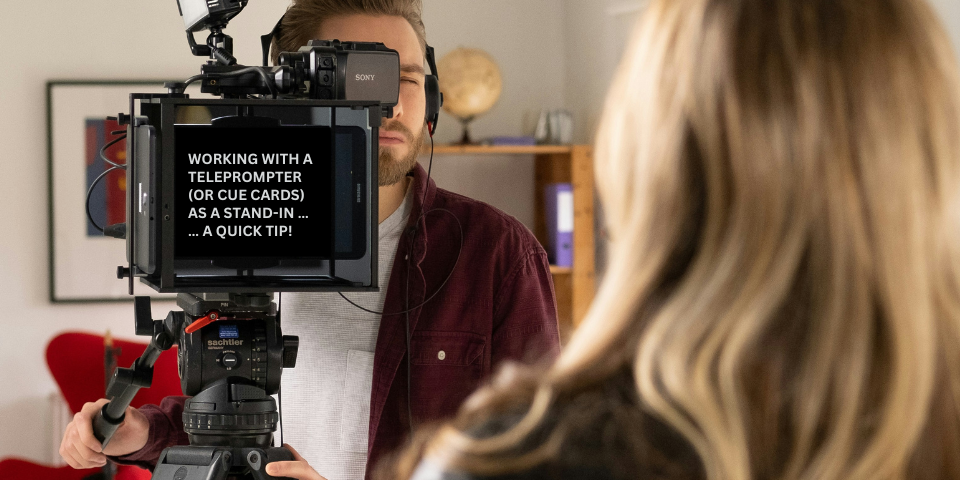As a new stand-in, you might not really have a grasp on what your role is.
Are you supposed to do the lines? Are you supposed to do a realistic portrayal? Are you supposed to “act”?
Or are you supposed to just stand there? Are you supposed to do any of the actions the actor did? Are you not supposed to do the lines? Are you not supposed to “act”?
If you’ve ever pondered these questions, you’re not alone. Every set is different! Some sets will have stand-ins do much of the same actions the actors did in rehearsal, as well as say the lines their actors say.
However, on the whole, this is not the case. In most stand-in jobs, the stand-ins don’t do the lines, don’t recreate all of the actions, and don’t “act.”
But, even if a stand-in job requires more of stand-ins, especially in recreating actions their actors did in rehearsal, there are limits to the recreation. Here are some pointers on what to recreate and how much to “act” when you are standing in.
Marking Rehearsal vs. Second-Team Rehearsal
When you’re standing in, you’ll usually get to watch one rehearsal with the actors before they leave the set for hair, makeup, and wardrobe. This is called marking rehearsal. It is called marking rehearsal because during this rehearsal, a camera assistant will usually place marks underneath the actors wherever they stand or stop in the scene. These marks are important to the stand-in because they tell the stand-in precisely where to stand, stop, and orient when standing in.
When the director, director of photography (DP), or camera department wants to see a rehearsal of the scene with the stand-ins, this is called a second-team rehearsal. Many second-team rehearsals are merely “point-to-points,” where the stand-ins move from one mark to their next marks for everyone to check out the shot.
How Important Is It for Stand-Ins to “Act” during Second-Team Rehearsal?
It is rarely important that the stand-ins “act” in second-team rehearsals because the objective of a second-team rehearsal is not to showcase the scene but instead to show the lighting, camera framing, and camera timing.
Minute, detailed movements in second-team rehearsal are rarely of importance in second-team rehearsals. So, it doesn’t matter if, say, you’re crying in a second-team rehearsal — if crying is what your actor did in the marking rehearsal. Instead, it matters where your actor stood, and what broad movements your actor made.
Essentially, if the movement affects the movement of the camera or the lighting in some way, it may be important for you to recreate it in second-team rehearsal.
Physical Commitment
Given this understanding that second-team rehearsal is more about showing the lighting, camera framing, and camera timing, how committed you are to your actor’s character when you are standing in is irrelevant.
It usually does not matter that you do a fully committed run-through of a scene when you are in a second-team rehearsal. If a scene has a lot of action and violence, as a stand-in your job is to perform the blocking your actor did in marking rehearsal — but full physical commitment is not required.
For example, if your actor had a violent physical encounter in the marking rehearsal, your job as the stand-in is not to repeat that violence. Instead, your job is to go to your mark where the encounter took place, and perhaps very lightly pantomime the violent actions. By no means should you put yourself or your fellow stand-ins in danger during a second-team rehearsal. If for some reason a dangerous action is needed for second-team rehearsal, stunt performers may be used in place of stand-ins to perform the action.
Ben’s Tip
If you feel uncomfortable with dangerous actions being required of you during a second-team rehearsal, or if you feel another stand-in may be performing a dangerous action during a second-team rehearsal that may affect you or other stand-ins, notify the 2nd 2nd AD or the 1st AD as soon as possible to prevent any safety issues, accidents, or injuries.
Lines & Emotional Commitment
You will get a sense how frequently a particular set asks its stand-ins to do lines in second-team rehearsals. (If it’s your first day on a set, you may want to ask other stand-ins if they usually do lines.) Rarely stand-ins do them, but it’s helpful for all stand-ins on all sets to be ready to do them should they be asked. Some sets will never have their stand-ins do the lines, then suddenly ask their stand-ins to do the lines in one scene.
In the rare instance you are asked to do lines, it is more important for you to say the lines close to exactly as they are scripted (noting any script updates that may have been made after marking rehearsal). But, you don’t need to worry about giving an emotionally committed performance of those lines.
Why? First off, you are probably not privy to the entire script or series, so the context of the character’s emotion is not entirely clear, so whether you give an emotionally appropriate performance will also be unclear.
Second, if you add to second-team rehearsal by taking time to “act,” you are working against the showcasing of the shot. Second-team rehearsal is not about you or your “acting.” Rather, it’s about the shot.
Third, the production cares more about the acting of its actors than of its stand-ins. Taking time to “act” during a second-team rehearsal could get back to the actor and may get in the actor’s head. While this may not happen, the outcome is plausible on some sets.
Exceptions
Of course, there are exceptions. Some productions will want an emotionally and/or physically committed stand-in to showcase the shot, especially when the actor is a producer, director, or not on set — to get a better sense of the look of the scene. If commitment will showcase the shot better, by all means, “act” to the best of your ability.
The trick in these situations is that less than acting, you are trying to repeat what your actor did in marking rehearsal. You might have a different interpretation of the lines or scene. In such a second-team rehearsal, it may not be valuable to “act” so much as simply “repeat what your actor did.”
All in all, keep in mind to keep your physical commitment in check when working with other stand-ins as not to injure them, and keep your emotional commitment also in check as not to waste production time with your “acting.”
More on “Acting”
By putting “acting” in quotation marks, there is no intention to belittle the acting talents of stand-ins. It is only to distinguish second-team acting from first-team acting. Surely there is something to say about being an actor who is also a stand-in and wanting to showcase your acting talents when working as a stand-in. Surely, also, some stand-ins have marketed their acting talents into jobs based on their physical and emotional commitment during second-team rehearsals.
However, usually “acting” supersedes the responsibilities of the stand-in, and oftentimes it borders on creating safety issues or drains on production time. If you ever have a question about how much you should do during a second-team rehearsal, simply ask!
Have any thoughts on how much “acting” you should do when you are standing in? Should you always, or never? Post your thoughts below!






Leave A Comment